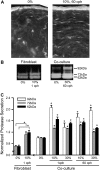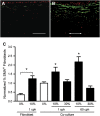Extracellular matrix remodeling by dynamic strain in a three-dimensional tissue-engineered human airway wall model
- PMID: 16601241
- PMCID: PMC2643283
- DOI: 10.1165/rcmb.2005-0443OC
Extracellular matrix remodeling by dynamic strain in a three-dimensional tissue-engineered human airway wall model
Abstract
Airway wall remodeling is a hallmark of asthma, characterized by subepithelial thickening and extracellular matrix (ECM) remodeling. Mechanical stress due to hyperresponsive smooth muscle cells may contribute to this remodeling, but its relevance in a three-dimensional environment (where the ECM plays an important role in modulating stresses felt by cells) is unclear. To characterize the effects of dynamic compression in ECM remodeling in a physiologically relevant three-dimensional environment, a tissue-engineered human airway wall model with differentiated bronchial epithelial cells atop a collagen gel containing lung fibroblasts was used. Lateral compressive strain of 10 or 30% at 1 or 60 cycles per hour was applied using a novel straining device. ECM remodeling was assessed by immunohistochemistry and zymography. Dynamic strain, particularly at the lower magnitude, induced airway wall remodeling, as indicated by increased deposition of types III and IV collagen and increased secretion of matrix metalloproteinase-2 and -9. These changes paralleled increased myofibroblast differentiation and were fibroblast-dependent. Furthermore, the spatial pattern of type III collagen deposition correlated with that of myofibroblasts; both were concentrated near the epithelium and decreased diffusely away from the surface, indicating some epithelial control of the remodeling response. Thus, in a physiologically relevant three-dimensional model of the bronchial wall, dynamic compressive strain induced tissue remodeling that mimics many features of remodeling seen in asthma, in the absence of inflammation and dependent on epithelial-fibroblast signaling.
Figures






Similar articles
-
Growth factors secreted by bronchial epithelial cells control myofibroblast proliferation: an in vitro co-culture model of airway remodeling in asthma.Lab Invest. 1999 Apr;79(4):395-405. Lab Invest. 1999. PMID: 10211992
-
An in vitro airway wall model of remodeling.Am J Physiol Lung Cell Mol Physiol. 2003 Aug;285(2):L427-33. doi: 10.1152/ajplung.00005.2003. Am J Physiol Lung Cell Mol Physiol. 2003. PMID: 12851213
-
Effect of extracellular matrix composition on airway epithelial cell and fibroblast structure: implications for airway remodeling in asthma.Ann Allergy Asthma Immunol. 2009 Mar;102(3):238-46. doi: 10.1016/S1081-1206(10)60087-7. Ann Allergy Asthma Immunol. 2009. PMID: 19354071
-
Role of extracellular matrix and its regulators in human airway smooth muscle biology.Cell Biochem Biophys. 2006;44(1):139-46. doi: 10.1385/CBB:44:1:139. Cell Biochem Biophys. 2006. PMID: 16456242 Review.
-
Role of human airway smooth muscle in altered extracellular matrix production in asthma.Clin Exp Pharmacol Physiol. 2001 Mar;28(3):233-6. doi: 10.1046/j.1440-1681.2001.03426.x. Clin Exp Pharmacol Physiol. 2001. PMID: 11236132 Review.
Cited by
-
Fibroblast-to-myofibroblast transition in bronchial asthma.Cell Mol Life Sci. 2018 Nov;75(21):3943-3961. doi: 10.1007/s00018-018-2899-4. Epub 2018 Aug 12. Cell Mol Life Sci. 2018. PMID: 30101406 Free PMC article. Review.
-
Airway remodelling in asthma: role for mechanical forces.Asia Pac Allergy. 2014 Jan;4(1):19-24. doi: 10.5415/apallergy.2014.4.1.19. Epub 2014 Jan 31. Asia Pac Allergy. 2014. PMID: 24527406 Free PMC article. Review.
-
Fibrotic response of tissue remodeling in COPD.Lung. 2011 Apr;189(2):101-9. doi: 10.1007/s00408-011-9279-2. Epub 2011 Feb 2. Lung. 2011. PMID: 21287182 Review.
-
Development of a 3D bioengineered human lung submucosal gland ductal airway model to study mucociliary clearance in vitro.Cell Biomater. 2025 Mar 25;1(2):100013. doi: 10.1016/j.celbio.2025.100013. Epub 2025 Mar 3. Cell Biomater. 2025. PMID: 40226365
-
Characteristics of medicine use for children with asthma in China: a nationwide population-based study.BMC Pediatr. 2022 Dec 28;22(1):740. doi: 10.1186/s12887-022-03720-5. BMC Pediatr. 2022. PMID: 36578005 Free PMC article.
References
-
- James A. Airway remodeling in asthma. Curr Opin Pulm Med 2005;11: 1–6. - PubMed
-
- Homer RJ, Elias JA. Airway remodeling in asthma: therapeutic implications of mechanisms. Physiology (Bethesda) 2005;20:28–35. - PubMed
-
- Cohn L, Elias JA, Chupp GL. Asthma: mechanisms of disease persistence and progression. Annu Rev Immunol 2004;22:789–815. - PubMed
-
- McParland BE, Macklem PT, Pare PD. Airway wall remodeling: friend or foe? J Appl Physiol 2003;95:426–434. - PubMed
-
- Jeffery PK. Remodeling in asthma and chronic obstructive lung disease. Am J Respir Crit Care Med 2001;164:S28–S38. - PubMed
Publication types
MeSH terms
Substances
Grants and funding
LinkOut - more resources
Full Text Sources
Other Literature Sources

